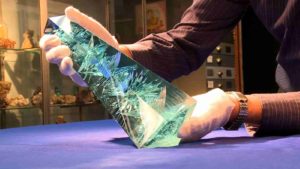
What is Aquamarine?
Aquamarine is a blue or cyan variety of beryl. It happens in most locations where normal beryl is produced. Sri Lanka’s deposits of gem-gravel placer contain aquamarine. Green-yellow beryl is sometimes referred to as chrysolite aquamarine, as happening in Brazil. Aquamarine’s deep blue version is called maxixe. Maxixe is frequently discovered in the Madagascar nation. When exposed to sunlight or undergoing heat treatment, its color fades to white, although the color returns with irradiation.
Aquamarine’s pale blue colour is ascribed to Fe2 +. Fe3 + electrons generate golden-yellow colour, and when both Fe2 + and Fe3 + are present, the colour is as dark as maxixe. Light or heat decoloration of the maxix may therefore be due to the transfer of charges between Fe3 + and Fe2 +. By irradiating it with high-energy particles (gamma rays, neutrons or even X-rays), dark-blue maxix color can be produced in green, pink or yellow beryl.
Aquamarines can be discovered at the Mt. Antero peak in the Sawatch Range in central Colorado in the United States. Aquamarine was found in Wyoming, close Powder River Pass, in the Big Horn Mountains. Another U.S. place is the Sawtooth Range close Stanley, Idaho, although the minerals are within a wilderness area that prohibits collection. In Brazil, in the countries of Minas Gerais, Espírito Santo, and Bahia, and in Rio Grande do Norte, there are mines. Aquamarine is also produced by Colombia, Zambia, Madagascar, Malawi, Tanzania and Kenya mines.
The biggest Cut aquamarine gem in the world
The aquamarine Dom Pedro is the biggest cut aquamarine gem in the world. It was trimmed from a crystal with an original weight of about 100 pounds (45 kg) and a span of over 3 feet (0.91 m). The rock was mined around 1980 in Pedra Azul, Brazil’s Minas Gerais state, named after the Brazilian emperors Pedro I and Pedro II.
Bernd Munsteiner cuted the blue-green gemstone into an obelisk shape weighing 10,363 carats. The completed size is 14 inches (36 cm) high by 4 inches (10 cm) broad. Jane Mitchell and Jeffery Bland donated the gem to the Smithsonian Institution. It is located in the Janet Annenberg Hooker Hall of Geology of the National Museum of Natural History.
Dom Pedro Aquamarine
The Dom Pedro Aquamarine, the biggest single piece of cut-gem aquamarine in the globe, will be permanently displayed at the National Museum of Natural History starting Dec. 6. In the Janet Annenberg Hooker Hall of Geology, Gems and Minerals such as the Hope Diamond and the Marie Antoinette necklace, it connects an illustrious set of renowned gemstones already on display. The piece was given by Jane M. Mitchell and Jeffery S. Bland. It is an extremely rare gem due to the quality of the initial crystal and its size, magnificent blue-green colour and unique shape.
“There’s so much noteworthy about the Dom Pedro, but what excites me most is that we can maintain the tale that comes with it,” said Kirk Johnson, National Museum of Natural History’s Sant Director. “The Dom Pedro is enhanced by all the people and places in the National Gem Collection that were component of his intriguing trip from the Earth’s crust to his home here. We are thankful for their fantastic donation to Jane Mitchell and Jeffery Bland.
Mined from a Brazilian pegmatite in the early 1980s, for the first two presidents of Brazil, Dom Pedro Primeiro and his brother, Dom Pedro Segundo, the splendid aquamarine was appointed. The portion of the beryl crystal from which the obelisk-shaped gem was fashioned was 23.25 inches long and weighed almost 60 pounds before cutting. The obelisk, built by Bernd Munsteiner, a world-renowned gem artist, lies 14 inches high, measures 4 inches across the foundation and averages 10,363 carats or 4.6 pounds. These amazing sizes make the Dom Pedro recognized as the biggest aquamarine cut-and-polished gem. A model of tapering “adverse splits” facing the sea-blue obelisk’s opposite sides helps to represent the light within the gem, giving the piece startling brightness and brightness. This notable sculpture appears to be illuminated from the inside with the correct lighting.
Munsteiner is considered one of the 20th century’s greatest gem artists, the “Father of the Fantasy Cut.” In order to produce gem carvings, he mixes traditional techniques with vibrant contemporary types. Born to a family of jewel carvers, Munsteiner’s job is the expression of an art practice that has gone from generation to generation.
At the era of 14, he became a family business apprentice and subsequently became a teacher at the School of Design in Phorzheim, Germany, where he graduated as a manufacturer of precious stones and jewelry. It was at college that Munsteiner was invited to bring the traditional cameo into a fresh shape for the first time, and he has since stretched borders and questioned traditional techniques. His faceting method recognized as “Fantasy Cuts” has influenced a modernization of the development of gem art, and the Dom Pedro Aquamarine exemplifies his creative style. Munsteiner spent four months researching the crystal carefully and another six months cutting, polishing and faceting to produce this unparalleled art job.
Apart from 350,000 mineral specimens, the Dom Pedro Aquamarine joins the Smithsonian’s famous gem and mineral collection of over 10,000 gems. The Smithsonian’s collection of gems and minerals is one of its biggest.










